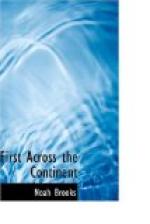“The river (the Missouri) continues about two hundred and fifty yards wide, with fewer sand-bars, and the current more gentle and regular. Game is no longer in such abundance since leaving the Musselshell. We have caught very few fish on this side of the Mandans, and these were the white catfish, of two to five pounds. We killed a deer and a bear. We have not seen in this quarter the black bear, common in the United States and on the lower parts of the Missouri, nor have we discerned any of their tracks. They may easily be distinguished by the shortness of the talons from the brown, grizzly, or white bear, all of which seem to be of the same species, which assumes those colors at different seasons of the year. We halted earlier than usual, and camped on the north, in a point of woods, at the distance of sixteen and one half miles (thus past the site of Fort Hawley, on the south).”
Notwithstanding the advance of the season, the weather in those great altitudes grew more and more cold. Under date of May 23, the journal records the fact that ice appeared along the edges of the river, and water froze upon their oars. But notwithstanding the coolness of the nights and mornings, mosquitoes were very troublesome.
The explorers judged that the cold was somewhat unusual for that locality, inasmuch as the cottonwood trees lost their leaves by the frost, showing that vegetation, generally well suited to the temperature of its country, or habitat, had been caught by an unusual nip of the frost. The explorers noticed that the air of those highlands was so pure and clear that objects appeared to be much nearer than they really were. A man who was sent out to explore the country attempted to reach a ridge (now known as the Little Rocky Mountains), apparently about fifteen miles from the river. He travelled about ten miles, but finding himself not halfway to the object of his search, he returned without reaching it.
The party was now just westward of the site of the present town of Carroll, Montana, on the Missouri. Their journal says:—
“The low grounds are narrow and without timber; the country is high and broken; a large portion of black rock and brown sandy rock appears in the face of the hills, the tops of which are covered with scattered pine, spruce, and dwarf cedar; the soil is generally poor, sandy near the tops of the hills, and nowhere producing much grass, the low grounds being covered with little else than the hyssop, or southernwood, and the pulpy-leaved thorn. Game is more scarce, particularly beaver, of which we have seen but few for several days, and the abundance or scarcity of which seems to depend on the greater or less quantity of timber. At twenty-four and one-half miles we reached a point of woodland on the south, where we observed that the trees had no leaves, and camped for the night.”
The “hyssop, or southernwood,” the reader now knows to be the wild sage, or sage-brush. The “pulpy-leaved thorn” mentioned in the journal is the greasewood; and both of these shrubs flourish in the poverty-stricken, sandy, alkaline soil of the far West and Northwest. The woody fibre of these furnished the only fuel available for early overland emigrants to the Pacific.




